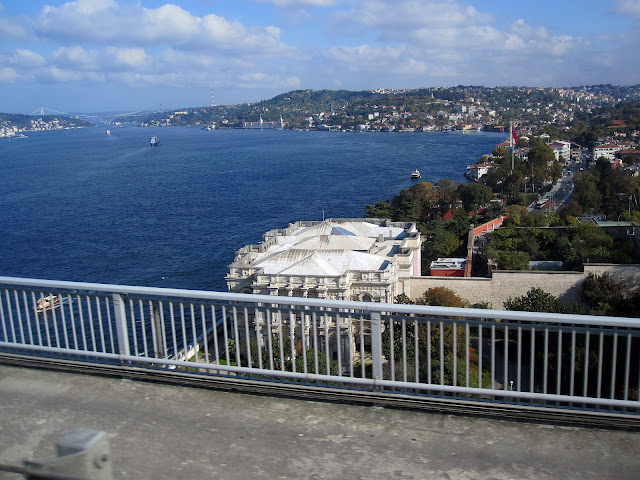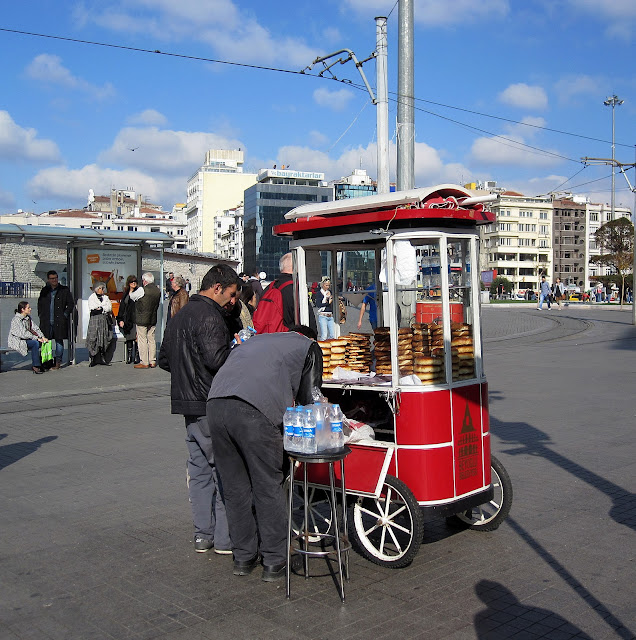There are two suspension bridges in Istanbul and they are building a third one for trucks and buses only.
The European side of Istanbul...
We arrived at Beylerbeyi Palace on the Asian side of the Bosphorus Strait, which was built by a Sultan in 1865. It has a beautiful garden with magnolia trees, and was used as a summer residence of the Ottoman Sultans and a house for visiting foreign dignitaries and heads of state.
The palace was made of limestone with a wooden interior and was decorated with the best of everything.
The entrance to the Palace with Lale, our guide, on the left.
A regal lion guarding the entrance. Love the paws!
Lovely gardens…
The suspension bridge was built right over the Palace gardens.
When the Republic of Turkey was declared in 1923, the Sultan was asked to move out of the country and the Palace was left exactly as it was when they lived in it.
We weren't allowed to take pictures inside, but someone bought postcards which we photographed. Most palace rooms were symmetrical in their decoration. If heads of state brought a gift, they were asked to bring two so that the room would be balanced. There were hundreds of chandeliers, all made with Italian Murano glass. Notice the symmetry...
This fountain helped to control the humidity and temperature of the palace. When the windows were opened, the breezes off the Bosphorus Strait would be cooled by the fountain.
One of the many rooms, mostly decorated in reds, used for greeting dignitaries.
Even the ceilings of the rooms were elaborately decorated.
The outside of the palace heading towards the kitchens...
Because the interior of the Palace was wooden, the kitchens presented a fire hazard so they were located outside.
We left the Palace to go back to the European side. You can see how the Palace was located right on the shores of the Bosphorus Strait.
The Bosphorus Strait joins the Black Sea and the Sea of Marmara.
Back on the European side!
These flats were constructed in the last 15 to 20 years to house the rapidly increasing population of Istanbul.
Our next top was the modern pedestrian shopping area. Every store imaginable was here.
This is where the locals shop, so it is not just a tourist area.
I kept looking at the many vendors selling bagels and pretzels and finally bought one. It was pretty good!
Although it is a pedestrian area, the streetcars were running, so you did have to pay attention and not just be gawking around.
As we noticed in Buenos Aires, most of the locals dress in dark or neutral colours.
For Megan and Heather…Sephora! (with the Turkish flag reflected in the window).
These ladies sit in the window making crepes…
This monument celebrated the 50th anniversary of the Republic in 1973.
We stopped at this silk store. Lale looks like a hunchback, but she actually had her purse on her back.
They had beautiful scarves and they weren’t too expensive, so I did a little Christmas shopping.
This vendor was blowing bubbles much to the kids’ delight.
Shopping in Istanbul is all done in districts. All the hardware stores will be in one area; all the lighting stores in another; all the shoe stores in another. I would think it would make it so hard for each vendor, but it seems to work for them. The following pictures are only about 1/20 of the wedding stores we passed in a one kilometre section. It was mind boggling!
Our next stop was the museum of the Chora Church. This 11th century church is one of the most important Byzantine monuments in Istanbul. Little is known of the early history of the church but “chora” means “in the country” so it suggests that it was a rural church. From 1315 to 1321 it was remodelled and the mosaics and frescoes were added, by Theodore Metochites, an elite Byzantine official of the time.
Outside the church was the usual variety of vendors.
Like other churches, it was turned into a mosque in the 1500s and the mosaics and frescoes were covered. It's great that they have been uncovered and the church has been converted into a museum.
Look at the amazing ceilings…
This fresco depicts The Last Judgment with the souls of the saved on the right side and those of the damned on the left.
This one depicts Christ dragging Adam and Eve out of their tomb. Under Christ’s feet are the gates of hell.
The next series showed the life of the Virgin Mary. Here she is learning to walk.
Often the architect would paint themselves in the fresco. Here is Theodore Metochites presenting the Chora Church to Christ.
One of the mosaics that could not be completely restored shows Mary and Jesus.
This beautiful dome shows Jesus in the centre with two rows of his ancestors from Adam to Jacob above and 12 sons of Jacob underneath.
Jesus performing his miracles...in this one on the right, he is restoring sight to the blind.
Jesus healing the sick.
Jesus healing the leper.
The Dormition of Mary shows Jesus holding a baby which represents the soul of Mary. The winged figure above Jesus is the Angel of Death.
Jesus depicted with light coloured hair shows that each person who paints Christ paints him as they envision him. For example, Swedish artists might paint him with blond hair and blue eyes.
The miracle of Jesus turning water into wine to feed the multitudes.
And bread enough to feed 5000, although there were not enough loaves to begin with.
Mary and Joseph’s Journey to Bethlehem.
The Enrolment for Taxation.
The walls of the old city…
And then we were back in the city and heading for the Spice Market. The streets were very congested.
The courtyard outside the Spice Market…
The New Mosque near the Market. It was a beautiful day!
The Spice Market, in the shape of an “L”, was built as an extension of the New Mosque for revenue. Built in the 1600s, the market came to specialize in spices from the Orient taking advantage of Istanbul’s site on the trade route between Asia and Europe.
This was the first shop Lale brought us to. She explained the differences between the Turkish Delights that are made with sugar and the better quality ones that are made with honey. Yummy samples!
Turkish Viagra! All I can say is that if you eat enough, you’ll get a real sugar rush!
All kinds of fresh nuts…
And dried fruit…
It was seriously too crowded for my liking. Mostly locals shop here...
Stalls upon stalls, all selling the same things. Saffron is big seller!
Transaction complete…
The sights and sounds of the spice market...
We left the market heading for a carpet store. The tower in the background is a fort built in 1453 to control the traffic on the Bosphorus Strait.
A group of “Free Syria” demonstrators…
We would have liked to have seen the Whirling Dervishes, but you can only do so much.
It was another wonderful, but exhausting day. We skipped out on the carpet store and walked back to the hotel. Tomorrow is Day 3 of our Istanbul tour before heading to the ship.








































































No comments:
Post a Comment